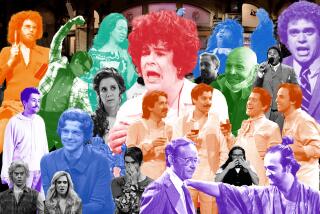Historic collection of Jewish artifacts to move to UC Berkeley
A beloved but sometimes forgotten center of Jewish history in the Bay Area will soon have a new home at UC Berkeley and, supporters hope, a new audience of researchers and admirers.
The collection of about 10,000 objects and documents, housed until recently at the Judah L. Magnes Museum in Berkeley, tells a broad and varied history of Jewish faith and life, both on the West Coast and far afield.
“There’s a kind of poignancy that’s in a lot of their collections, and a kind of broader perspective on what Jewish culture is,” said Ron Hendel, chairman of UC Berkeley’s Jewish studies program. The program will share facilities with the collection in its new home just off the university campus.
The museum’s collection has moved out of its longstanding home in a residential area south of the university campus and is slated to open in a renovated building adjacent to the campus in downtown Berkeley. It will be called the Magnes Collection of Jewish Art and Life at the university’s Bancroft Library.
The collection amassed over the years by the museum and its founder, Seymour Fromer, who died last October, includes an ornate 17th century Torah ark from Cochin, India, painted in red, green and gold; a 1938 architectural drawing of a school from Soviet Jewish architect Lazar Khidekel; and a collection of some 5,000 postcards detailing Jewish life from the late 19th century to mid-20th century.
The Magnes also housed the Western Jewish History Archives, the world’s largest collection of letters, diaries and photographs from the Jewish settlement of the West. Those archival materials will merge into the Bancroft’s existing collection.
Mark Reisbaum, chief endowment officer of the Jewish Community Federation of San Francisco, said the history preserved in the collection helps keep the often-secular West Coast Jewish community in touch with its cultural roots.
“As Jews, we always have one foot in our history and one foot in our future,” he said.
“Particularly in California, the majority of Jews don’t identify through the religious and spiritual side but identify rather through cultural identity and history.”
Since the museum’s founding in 1962, the history housed there has influenced local culture in sometimes unexpected ways.
For instance, old recordings at the museum helped kick off the worldwide klezmer music revival of the 1970s and ‘80s when Lev Liberman, who became co-founder of the pioneering klezmer revival band the Klezmorim, went to the Magnes in 1975 in search of 78-rpm recordings of largely forgotten Eastern European Yiddish instrumental music. He found what he was looking for in a stack of old records tucked away in a drawer at the museum.
But many others never made the trip to see the collection, which remained secluded in a historic mansion building, far from public transit and the city’s downtown.
“It was not on people’s radar screens,” said Rabbi Stephen S. Pearce of Congregation Emanu-El of San Francisco.
Economic expediency finally forced a move that many say will bring the collection greater prominence and use.
Alla Efimova, who was the curator of the Magnes Museum and is now director of the new collection at UC Berkeley, said that since the 1990s, the museum had been looking for a way to move to the heart of Berkeley and make its collection more accessible. In 1997, the museum bought a downtown building and began looking for funding to renovate it and move the collection.
In 2002, the museum entered into a short-lived merger with the Contemporary Jewish Museum, then the Jewish Museum San Francisco, but the two organizations could not reconcile their missions, and the partnership dissolved.
After the current recession started, Efimova said, the Magnes board and staff decided that the best way to preserve the collection and its scholarly mission was to integrate it with the university.
“Because of the economy, we were forced to make this decision to reexamine the core mission of the museum and, in a way, it provided us with kind of an elegant solution,” she said.
The building that will house the collection will remain under the ownership of the Magnes Museum Foundation, and its contents are being donated to the university.
Commitments of $2.5 million over five years from philanthropists Warren Hellman, Tad Taube and the Koret Foundation are expected to pay for transfer of the collection, with donations from other private sources paying for the renovation of the downtown building.
Bancroft Library director Charles Faulhaber said the target date to open the new facility is the fall of 2011. In addition to the art and artifacts, the building will house parts of the university’s Jewish studies program.
The archival materials will become available over the next year, as they are integrated into the Bancroft collection.
More to Read
The biggest entertainment stories
Get our big stories about Hollywood, film, television, music, arts, culture and more right in your inbox as soon as they publish.
You may occasionally receive promotional content from the Los Angeles Times.











